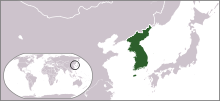Pulsatilla koreana
Pulsatilla koreana, the Korean pasque flower (Korean Hal-mi-kkot, 할미꽃), is one species of the genus Pulsatilla. P. koreana is a hairy, tufted, perennial herb. It is a native perennial plant growing in Korea and used as a traditional Korean herbal medicine.
| Pulsatilla koreana | |
|---|---|
| Pulsatilla koreana | |
| Scientific classification | |
| Kingdom: | |
| (unranked): | |
| (unranked): | |
| Order: | |
| Family: | |
| Tribe: | |
| Genus: | Pulsatilla |
| Species: | P. koreana |
| Binomial name | |
| Pulsatilla koreana | |
Description
Pulsatilla koreana has six petal-like segments that have a silky exterior; stamens in a central boss are surrounded by a ring of staminoids. Leaves are 3–4 cm (1.2–1.6 in) long and are two- to three-lobed. The leaves are pinnate in a basal rosette and there are five leaflets which are white-woolly pubescent (covered with erect hairs) beneath. The plant has bell-shaped flowers with scapose and pendent, blooming in spring. The flowers are hermaphrodite (have both male and female organs) and are pollinated by insects. They are solitary terminal on a peduncle of 30–40 cm (12–16 in) length. The flower is about 35 cm (14 in) long, 12 mm (0.47 in) across, and its color is usually red to purple. Fruit is borne in heads with long feather styles.
Distribution and cultivation
Pulsatilla koreana is a native perennial plant growing in Korea. According to its native range, it is likely to succeed outdoors in most areas of the country. The following notes are based on the general needs of the genus Pulsatilla. The plant requires a well-drained, humus-rich, gritty soil and a sunny position. It also tolerates acid, neutral and basic (alkaline) soils and can grow in very alkaline soil. The plant prefers light (sandy) and medium (loamy) soils. It cannot grow in the shade and requires moist soil.
Traditional medicine
Pulsatilla koreana is a traditional Korean herbal medicine.[1]
Fairy tale
Pulsatilla koreana is called the "grandmother flower" in Korea. A long time ago, according to a fairy tale, there was a widow who had two daughters. The older daughter married a rich man but the younger daughter married a man who wasn't as luxurious. Time passed and the widow was now very old and she decided to visit her two daughters. However the older one refused to let her stay and she was forced out of the house. So the widow turned to her younger daughter. But she lived very far away over many mountains. The widow fainted while going over the mountain from exhaustion. Some hours later, the younger daughter found her mother but it was already too late and she ended up dying. The younger daughter was extremely sad and buried her near the house. The next spring, a flower bloomed over her grave. The flower was bent like her mother's back. So the daughter believed her mother had come back as the "grandmother flower".
References
- Medicinal Plants in the Republic of Korea. Manila: World Health Organisation. 1998. ISBN 92-9061-120-0.
| Wikimedia Commons has media related to Pulsatilla koreana. |
- Bird. R. (Editor) Focus on Plants. Volume 5. (formerly 'Growing from seed') Thompson and Morgan. 1991
- Hatfield. A. W. How to Enjoy your Weeds. Frederick Muller Ltd 1977 ISBN 0-584-10141-4
- Huxley. A. The New RHS Dictionary of Gardening. 1992. MacMillan Press 1992
- http://www.asianinfo.org/asianinfo/north%20korea/pro-wildlife.htm
